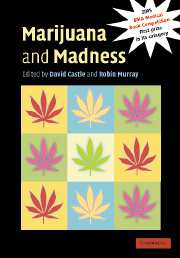Book contents
- Frontmatter
- Contents
- List of contributors
- Foreword
- Preface
- 1 The cannabinoid system: from the point of view of a chemist
- 2 How cannabis works in the brain
- 3 Acute and subacute psychomimetic effects of cannabis in humans
- 4 The association between cannabis use and depression: a review of the evidence
- 5 Cannabis and psychosis proneness
- 6 Is there a specific ‘cannabis psychosis’?
- 7 Cannabis as a potential causal factor in schizophrenia
- 8 Cannabis abuse and the course of schizophrenia
- 9 The endogenous cannabinoid system in schizophrenia
- 10 Cannabinoid ‘model’ psychosis, dopamine–cannabinoid interactions and implications for schizophrenia
- 11 Motives that maintain cannabis use among individuals with psychotic disorders
- 12 Addressing cannabis abuse in people with psychosis
- 13 Residual cognitive effects of long-term cannabis use
- Index
- References
5 - Cannabis and psychosis proneness
Published online by Cambridge University Press: 07 December 2009
- Frontmatter
- Contents
- List of contributors
- Foreword
- Preface
- 1 The cannabinoid system: from the point of view of a chemist
- 2 How cannabis works in the brain
- 3 Acute and subacute psychomimetic effects of cannabis in humans
- 4 The association between cannabis use and depression: a review of the evidence
- 5 Cannabis and psychosis proneness
- 6 Is there a specific ‘cannabis psychosis’?
- 7 Cannabis as a potential causal factor in schizophrenia
- 8 Cannabis abuse and the course of schizophrenia
- 9 The endogenous cannabinoid system in schizophrenia
- 10 Cannabinoid ‘model’ psychosis, dopamine–cannabinoid interactions and implications for schizophrenia
- 11 Motives that maintain cannabis use among individuals with psychotic disorders
- 12 Addressing cannabis abuse in people with psychosis
- 13 Residual cognitive effects of long-term cannabis use
- Index
- References
Summary
In many countries, a large proportion of the general population is now exposed to cannabis, as a result of its widespread recreational use (Webb et al., 1996; Smart and Ogborne, 2000). From a public health point of view, a careful assessment of the impact of cannabis on mental health in general-population subjects is thus warranted, in order to decide whether prevention strategies aimed at reducing exposure to this drug are justified. Investigation of the mental health characteristics of cannabis users in the general population is especially important for identification of a potential aetiological risk factor for severe mental illness. Converging findings obtained by prospective population-based cohort studies suggest that cannabis use may be an independent risk factor for the onset of psychosis (Andreasson et al., 1987; Arseneault et al., 2002; van Os et al., 2002; Weiser et al., 2002).
However, the nature of the link between cannabis use and psychosis is far from being elucidated. Findings drawn from clinical samples of subjects identified as cases of psychosis have limited value in shedding light on the mechanisms underlying this association, as the potential confounding factors linked to the clinical status of the subjects are difficult to control in such samples. Thus, studies exploring factors modulating the expression of psychosis in non-clinical populations may better identify causal risk factors for psychosis than studies carried out in clinical samples (Verdoux et al., 1998b, van Os et al., 2000; 2001; Verdoux and van Os, 2002).
- Type
- Chapter
- Information
- Marijuana and MadnessPsychiatry and Neurobiology, pp. 75 - 88Publisher: Cambridge University PressPrint publication year: 2004
References
- 9
- Cited by



